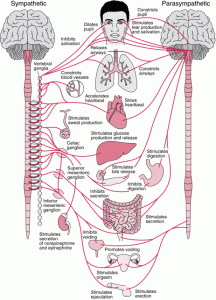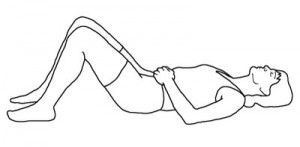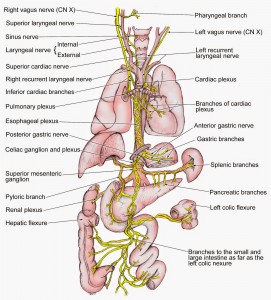The part of the nervous system that is specifically involved with the stress response (described in details in previous post) is the autonomic nervous system (a.k.a involuntary) responsible for the automatic (without thinking) control of basic essential and visceral functions (respiration, heart rate, digestion…). The autonomic nervous system is comprised of two antagonist systems, two distinct networks of nerves connecting the same organs but with opposite effects: the sympathetic nervous system stimulates action as in the stress response, where it prevails, while the parasympathetic system is responsible for rest and regeneration (both do so by inhibiting or stimulating this or that, see image). The nerve branches of the sympathetic system exit the spine at the thoracic and lumbar vertebras, while the nerve branches of the parasympathetic exit the spine at the cervical and sacred vertebras.
In the stress response, the sympathetic nervous system is king. Breathing is faster and shallower. The muscular work/effort of breathing (which always involves various principal and accessory muscles) tends to be concentrated in the shoulders and thorax, with the diaphragm not going down very low in the abdomen. Next time you feel stressed, anxious, observe what is happening with your breathing, what do you notice? (notice, for example, how your tummy is sticking in and not ballooning out like a kid’s). We cannot control the fact that we breathe to be alive -that’s where the autonomic nervous system is involved- but we can have control over HOW we breathe thanks to our central nervous system and brain.
To switch to the parasympathetic system, that will favor a state of relaxation, you can try deep abdominal breathing. Lower the shoulders (=lower the guard !), lie down if you can, place a soft hand on your stomach, another one on the thorax/heart (feel the heart pounding and later feel how it slows down). Breathe in through the nose, extend your diaphragm to the max, let air in all the way DOWN to the most remote places of your obscure belly, let your abdomen fully BALLOON. Breathe out (empty slow the balloon) through the mouth until there is no air left down there. Then, naturally, just like a pump, fill your belly up again. Think only of what you are doing : breathing in and out, and FEEL what it feels like. What does it feel like in the stomach when it stretches to the shape of a balloon ? What does it feels like to have that “knot” at the solar plexus slowly soften, untie ? There in your plexus, travels a very important nerve of the parasympathetic system, called the vagus nerve. The movements of your deep diaphragmatic breathing will likely stimulate this nerve and help you switch systems, from sympathetic to parasympathetic. Meanwhile, the fact that you are no longer breathing so much in the thorax will lessen the stimulation to the nerve branches of the sympathetic system that exit at these vertebras and also contribute to that switch. Slower heartbeat, loose breathing, that chilly feeling, laid-back stomach sounds (indicating a restart of peristalsis) all signal that you have made it to a quieter state.
Practice on yourself so that you are ready when it IS important that you come down. Practicing on yourself will then allow you to practice on someone else who might need your help to achieve this switch. It is a very caring hack that requires patience, trust, confidence. You do not impose a way of breathing to someone, you create a space, conditions and contact that are welcoming for them to find their way to relaxation through deep breathing. I have practiced it with success on myself and on people when they showed up at my massage table with a lot of anxiety.
This article is part of a previous larger article about the stress response: HACK STRESS and prevent damages to yourself (and others) in the process of fighting for your ideals






